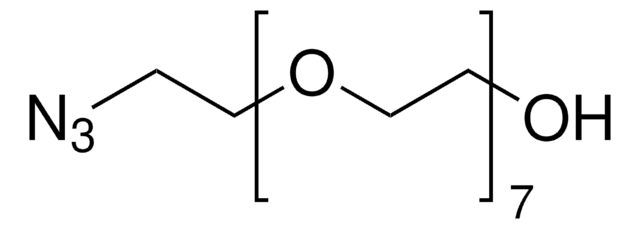712590
O-(2-Azidoethyl)-O′-methyl-triethylene glycol
≥90% (NMR)
Synonym(s):
1-{2-[2-(2-Azidoethoxy)ethoxy]ethoxy}-2-methoxyethane, 13-Azido-2,5,8,11-tetraoxatridecane
About This Item
Recommended Products
assay
≥90% (NMR)
form
liquid
mol wt
average Mn 200
reaction suitability
reaction type: click chemistry
reagent type: cross-linking reagent
Ω-end
azide
α-end
methoxy
storage temp.
2-8°C
SMILES string
COCCOCCOCCOCCN=[N+]=[N-]
InChI
1S/C9H19N3O4/c1-13-4-5-15-8-9-16-7-6-14-3-2-11-12-10/h2-9H2,1H3
InChI key
FFOZZVDSANUDAE-UHFFFAOYSA-N
Packaging
Certificates of Analysis (COA)
Search for Certificates of Analysis (COA) by entering the products Lot/Batch Number. Lot and Batch Numbers can be found on a product’s label following the words ‘Lot’ or ‘Batch’.
Already Own This Product?
Find documentation for the products that you have recently purchased in the Document Library.
Customers Also Viewed
Articles
Circulatory half-life is a key success factor for new drugs. In this respect, PEGylation or PEG-ing—the modification of potential candidates ranging from non-peptidic small molecules to peptides and proteins, antibody fragments, aptamers, and saccharides or oligonucleotides with polyethylene glycol chains—offers numerous advantages.
Prof. Randal Lee discusses iron oxide magnetic nanospheres and nanocubes design considerations for biosensing applications.
Kanjiro Miyata (The University of Tokyo, Japan) provides insights on the rational design of polymeric materials for “smart” oligonucleotide delivery.
Designing biomaterial scaffolds mimicking complex living tissue structures is crucial for tissue engineering and regenerative medicine advancements.
Our team of scientists has experience in all areas of research including Life Science, Material Science, Chemical Synthesis, Chromatography, Analytical and many others.
Contact Technical Service


![2-[2-(2-Azidoethoxy)ethoxy]ethanol solution ~0.5 M in tert-butyl methyl ether](/deepweb/assets/sigmaaldrich/product/structures/374/007/eea7ca74-41e4-4aac-af71-c93c37ec0a5a/640/eea7ca74-41e4-4aac-af71-c93c37ec0a5a.png)


![O-[N-(3-Maleimidopropionyl)aminoethyl]-O′-[3-(N-succinimidyloxy)-3-oxopropyl]heptacosaethylene glycol ≥90% (oligomer purity)](/deepweb/assets/sigmaaldrich/product/structures/367/864/1c31a65f-501f-4464-8bb3-edff0d131a12/640/1c31a65f-501f-4464-8bb3-edff0d131a12.png)








